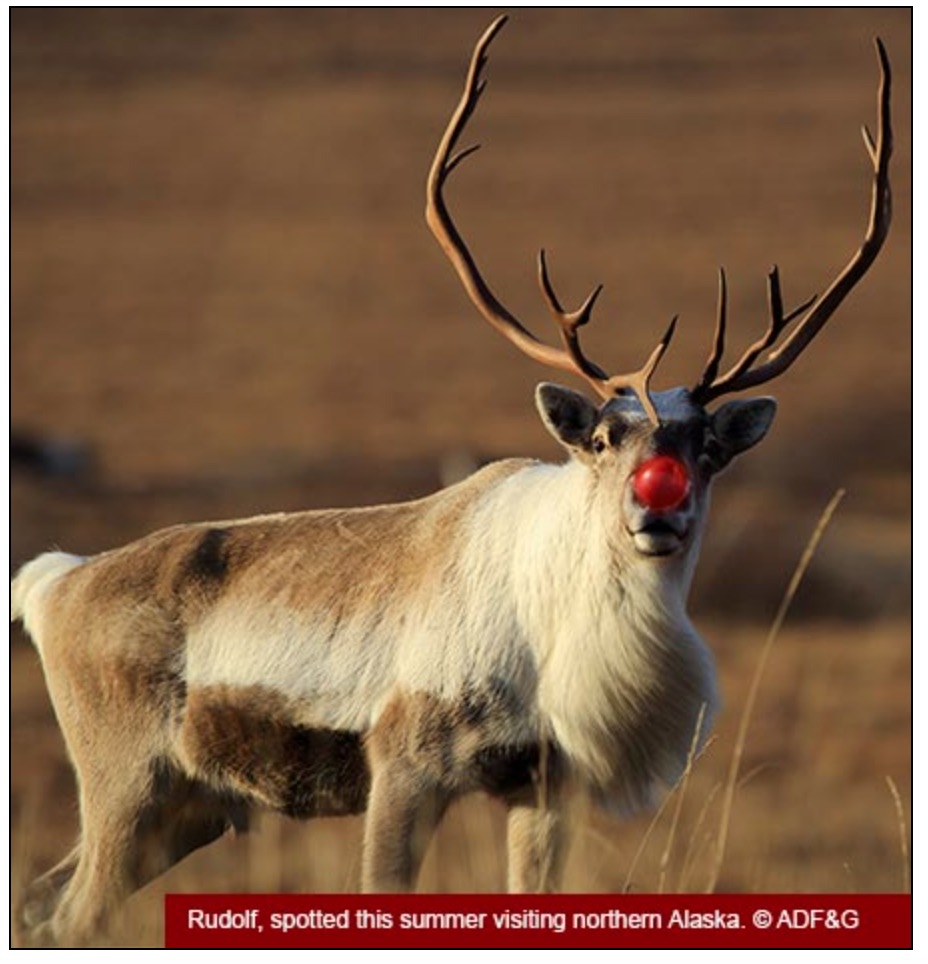Just in time for the big ride, the Alaska Department of Fish and Game has posted a biological report on Santa’s reindeer on its animal profile web page. Included is a photograph of Rudolph and his red nose.
According to the report, “Santa’s reindeer (R.t. saintnicolas magicalus) look very similar to common reindeer or caribou, but have many characteristics that distinguish them from the seven other common subspecies. In Europe, caribou are called reindeer, but in Alaska and Canada only the semi-domesticated form is called reindeer.
“All caribou and reindeer throughout the world are considered to be the same species, and, including Santa’s reindeer (R.t. saintnicolas magicalus), there are 8 subspecies: barrenground (Rangifer tarandus granti), Svalbard (R.t platyrhynchus), European (R.t. tarandus), Finnish forest reindeer (R.t. fennicus), Greenland (R.t. groenlandicus), woodland (R.t. caribou) and Peary (R.t. pearyi). Alaska has mostly the barren-ground subspecies and one small herd of woodland caribou. Canada has three subspecies, the Peary, woodland and barren-ground.”
Who knew?
As for the reindeers’ usual diet, the department says “Santa’s reindeer eat the leaves of willows, sedges, flowering tundra plants, and mushrooms during the summer. They switch to lichens (reindeer moss), dried sedges (grass-like plants), and small shrubs (like blueberry) in September. An interesting question is how such foraging behavior is possible at the North Pole, an icy region in which plant life can’t be said to prosper. But then again, Santa’s house is not an ordinary place.”
“The diet of Santa’s reindeer during the month of December consists almost entirely of carrot snacks. This enables them to fly long distances, during short periods of time, in unfavorable visibility conditions.”
Carrots, people. Santa’s reindeer love Alaska carrots.
The migration patterns of Santa’s reindeer are the subject of scientific differences, the department reports. Whether the annual night flight of R.t. saintnicolas magicalus may technically be considered a migration is debated in scientific circles. Further, the reindeer won’t be wearing masks as they circle the globe because they are immune from the coronavirus.

“Though there are very few Santa’s reindeer, they are not listed as threatened or endangered. This is due to their unusual life expectancy, which is infinite,” the profile says.
Must Read Alaska sources say Santa has begun his trek around the globe and is expected back in Alaska after midnight. The weather across Alaska is Christmassy, at 36 degrees in Ketchikan, and -1 degree in Utqiagvik.
More fascinating details about Santa’s reindeer ecology from the jolly ol’ biologists at Fish and Game are found at the department’s species profile catalog at this link.

Right now Anchorage spirit can use a sleigh on wheels being pulled by eight reindeer jingling thru neighborhoods, but an unmasked Christmas decorated firetruck handing out candy canes going thru the neighborhoods will do. The candy canes red symbolize the blood of Jesus Christ covering man’s sins since Adam and Eve, and the cane is for the Jesus is the Shepard, and turned upside down is J for Jesus. My favorite the twinkle lights decorating the AFD truck the lights represents the little light inside of each of us and when we are strung together by the Vine we make the whole room bright.
Fish and Game is on The Naughty List and has been for years. I don’t trust what they might say about Santa’s anything.